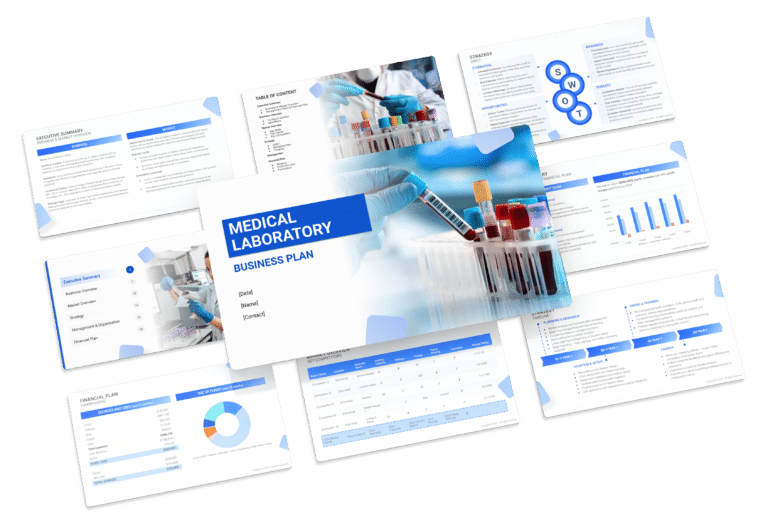Pharmacy Business Plan Template & PDF Example

Creating a comprehensive business plan is crucial for launching and running a successful pharmacy. This plan serves as your roadmap, detailing your vision, operational strategies, and financial plan. It helps establish your pharmacy’s identity, navigate the competitive market, and secure funding for growth.
This article not only breaks down the critical components of a pharmacy business plan, but also provides an example of a business plan to help you craft your own.
Whether you’re an experienced entrepreneur or new to the healthcare industry, this guide, complete with a business plan example, lays the groundwork for turning your pharmacy concept into reality. Let’s dive in!
The Plan
Our pharmacy business plan is constructed to encompass all critical facets required for a robust strategy. It details the pharmacy’s operational processes, marketing approaches, market conditions, competitive landscape, management hierarchy, and financial predictions.
- Executive Summary: Provides a concise overview of the Pharmacy’s business concept, market analysis, management team, and financial strategy, setting the stage for the detailed plan.
- Business Overview: Offers insight into what the Pharmacy provides and its operational model.
- Pharmacy & Location: Details the pharmacy’s layout, amenities, and the strategic significance of its location to attract customers.
- Services & Pricing: Lists the pharmaceutical services and products available, including pricing strategy and how it caters to the target market.
- Market Overview: Explores the pharmaceutical landscape, identifying the Pharmacy’s position in the market.
- Key Stats: Shares important statistics on the pharmacy industry, highlighting the market size and growth trends.
- Key Trends: Discusses current trends affecting the pharmaceutical industry and how the Pharmacy aligns with these trends.
- Key Competitors: Evaluates main competitors in the vicinity, showcasing the Pharmacy’s unique advantages.
- Strategy: Describes how the Pharmacy aims to achieve growth and attract customers.
- SWOT: Strengths, weaknesses, opportunities, and threats analysis tailored to the Pharmacy.
- Marketing Plan: Outlines strategies for marketing, customer engagement, and loyalty building.
- Timeline: Key milestones and objectives from the Pharmacy’s startup phase through its first year of operation.
- Management: Information about the management team, their expertise, and their roles in the Pharmacy.
- Financial Plan: Projects the Pharmacy’s financial performance over the next five years, including revenue, profit margins, and significant expenses.

Executive Summary
The Executive Summary introduces your pharmacy’s business plan, providing a concise overview of your pharmacy and its offerings. It should detail your market positioning, the range of pharmaceutical products and health services you offer, its location, size, and an outline of day-to-day operations.
This section should also explore how your pharmacy will integrate into the local market, including the number of direct competitors within the area, identifying who they are, along with your pharmacy’s unique selling points that differentiate it from these competitors.
Furthermore, you should include information about the management and co-founding team, detailing their roles and contributions to the pharmacy’s success. Additionally, a summary of your financial projections, including revenue and profits over the next five years, should be presented here to provide a clear picture of your pharmacy’s financial plan.
Pharmacy Business Plan Executive Summary Example


Business Overview
When crafting the executive summary for your pharmacy, it’s essential to succinctly present key information about your business. This includes your pharmacy’s name, its strategic location, and a snapshot of day-to-day operations.
These foundational details serve not only as an introduction but also as a platform to highlight what sets your pharmacy apart. Your unique selling proposition (USP) is critical in distinguishing your pharmacy from competitors. It could be your innovative healthcare services, the integration of digital health solutions, or your focus on community wellness initiatives. This USP should be the centerpiece of your executive summary, illustrating the distinct value your pharmacy contributes to the healthcare landscape.
Example:
“Community Health Pharmacy,” nestled in the heart of the bustling Greenwood neighborhood, occupies a 2,000 sq. ft. space on Elm Street. With doors opening at 8 AM, it offers a comprehensive array of pharmaceutical services, including specialized medication management programs. Its USP lies in the blend of high-tech health management tools with personalized care, catering to a diverse clientele seeking both convenience and quality in their healthcare experiences.
Market Overview
A thorough understanding and presentation of the market dynamics are crucial components of the executive summary. This segment should illuminate the scope and growth trajectory of the pharmacy industry, supported by pertinent data such as market valuation and growth trends.
Discussion of industry trends is vital, including the shift towards more integrated healthcare services within pharmacies or the proliferation of digital pharmacy platforms, which reflects the changing contours of the market and your pharmacy’s place within it.
The competitive landscape is also a key element. Your executive summary should pinpoint major competitors and delineate your pharmacy’s competitive edge. Whether it’s through specialized services, exceptional customer engagement, or innovative health programs, this section is an opportunity to highlight how your pharmacy is uniquely positioned to excel.
Example:
In the dynamic U.S. pharmacy market, valued at $527 billion with a 3.7% CAGR from 2023 to 2030, “Community Health Pharmacy” carves out its niche. Amidst the competitive fray with five primary competitors in Greenwood, it sets itself apart through a focus on digital health integration and comprehensive wellness programs, appealing to the modern, health-conscious consumer.
Management Team
The collective experience and expertise of your management team are invaluable assets to your pharmacy. In this part of the executive summary, emphasize the diverse skills and backgrounds of your team members.
This could involve highlighting the extensive pharmaceutical experience of your lead pharmacist or the innovative business strategies brought forth by your management team. Showcasing the depth of your team’s expertise not only enhances credibility but also reassures potential investors and partners of your pharmacy’s capacity for success and growth.
Example:
At “Community Health Pharmacy,” the leadership team, led by co-founders Morgan Bailey and Alex Rivera, is a powerhouse. Morgan, with over a decade in pharmaceutical services, brings a wealth of industry knowledge, while Alex, known for pioneering healthcare tech solutions, drives the pharmacy’s innovative edge, setting a solid foundation for operational excellence and strategic growth.
Financial Plan
Your financial plan should concisely outline your financial aspirations and projections, including anticipated revenue streams and profitability margins, offering a clear vision of your pharmacy’s financial future.
Example:
With a goal of achieving $4.1 million in annual revenue by 2028 and an 11% EBITDA margin, “Community Health Pharmacy” is on a steadfast path to financial robustness. The financial blueprint revolves around strategic investments in cutting-edge healthcare technologies and community-centric services, buoyed by effective marketing and robust operational efficiencies, paving the way for sustained profitability and a prominent standing within the Greenwood community.
Business Overview
For a Pharmacy, the Business Overview section can be concisely divided into 2 main aspects:
Pharmacy & Location
Briefly describe the pharmacy’s physical setup, focusing on its layout, ease of navigation, and the welcoming atmosphere for customers. Mention the pharmacy’s location, highlighting its accessibility and convenience to customers, such as proximity to medical centers, residential areas, or ease of parking. Explain why this location is strategically chosen to attract your target customer base.
Products & Pricing
Detail the range of products and services offered, from prescription medications and over-the-counter drugs to health supplements and wellness products. Include any specialized services such as pharmaceutical consultations, immunizations, health screenings, or medication management programs.
Outline your pricing strategy, ensuring it is competitive yet reflects the quality and value of the products and services offered. Highlight any discount programs, insurance collaborations, or loyalty schemes that provide added value to your customers, encouraging repeat visits and customer loyalty.
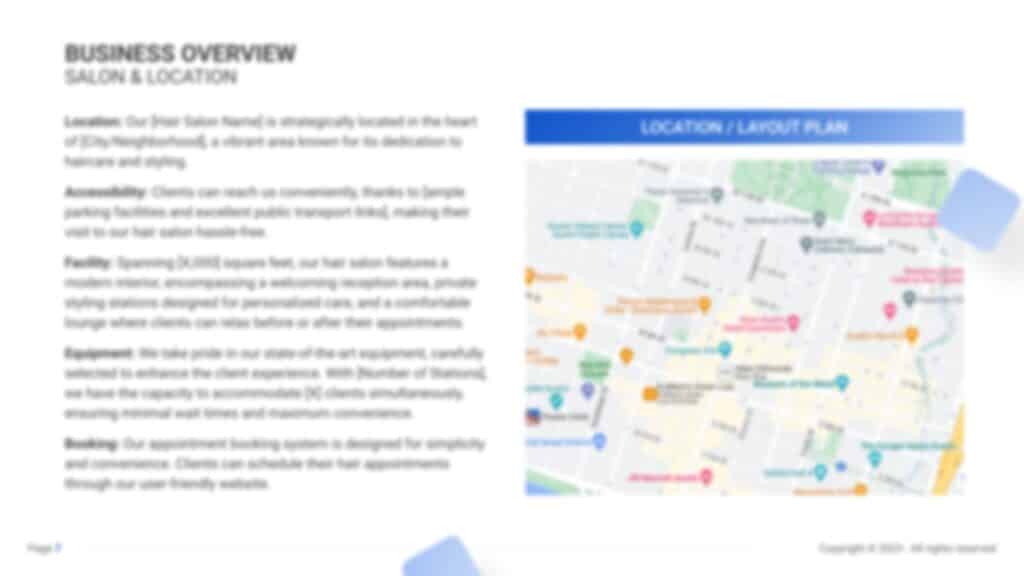
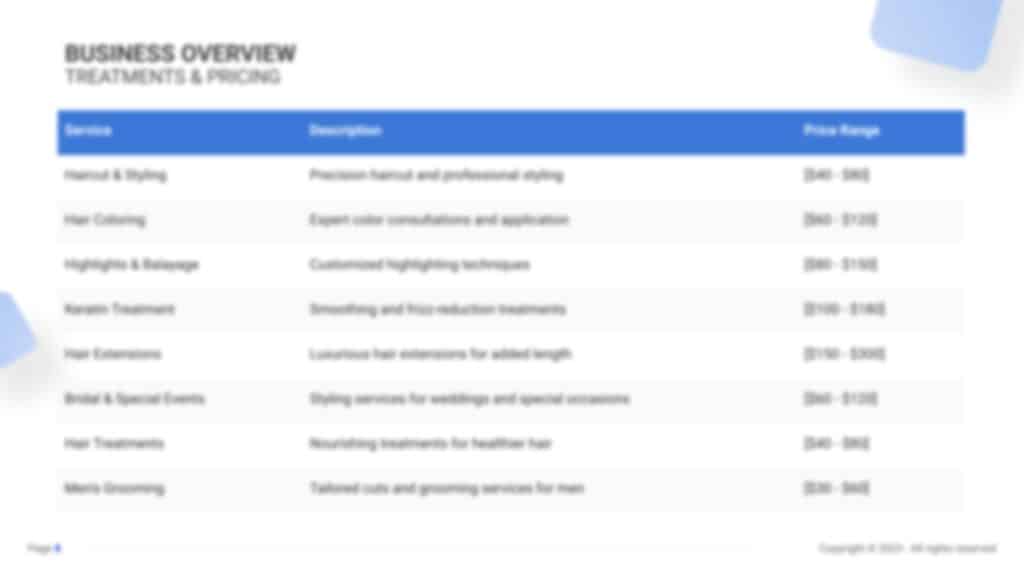
Market Overview

Industry Size & Growth
In the Market Overview of your pharmacy business plan, start by examining the size of the pharmaceutical industry and its growth potential. This analysis is crucial for understanding the market’s scope and identifying expansion opportunities.
Key Market Trends
Proceed to discuss recent market trends, such as the increasing consumer interest in health and wellness products, the growth in demand for prescription and over-the-counter medications, and the expansion of pharmacy services like immunizations and health screenings. For example, highlight the demand for pharmacies that offer comprehensive health management solutions and personalized medication consultations, alongside the rising popularity of digital health services and telepharmacy.
Competitive Landscape
A competitive analysis is not just a tool for gauging the position of your pharmacy in the market and its key competitors; it’s also a fundamental component of your business plan.
This analysis helps in identifying your pharmacy’s unique selling points, essential for differentiating your business in a competitive market.
In addition, the competitive analysis is integral to laying a solid foundation for your business plan. By examining various operational aspects of your competitors, you gain valuable information that ensures your business plan is robust, informed, and tailored to succeed in the current market environment.
Identifying Your Competitors in the Pharmacy Sector
The initial step in grasping your position in the pharmacy market is to identify your competitors. Start by cataloging local pharmacies, including big-chain pharmacies, independent local drugstores, and even supermarkets or department stores with pharmacy sections.
If your pharmacy focuses on specialized services, like compounding or wellness programs, your direct competitors include other pharmacies offering similar services, as well as online pharmacies. Indirect competitors might consist of health food stores or clinics providing alternative medicine solutions.
Utilize online resources such as Google Maps for a geographical overview of competitor distribution. Platforms like Yelp and Healthgrades provide customer feedback and ratings, offering a peek into competitors’ strengths and potential areas for improvement. For instance, if multiple reviews praise the efficient prescription refill system of “FastCare Pharmacy,” this represents a significant strength of your competitor.
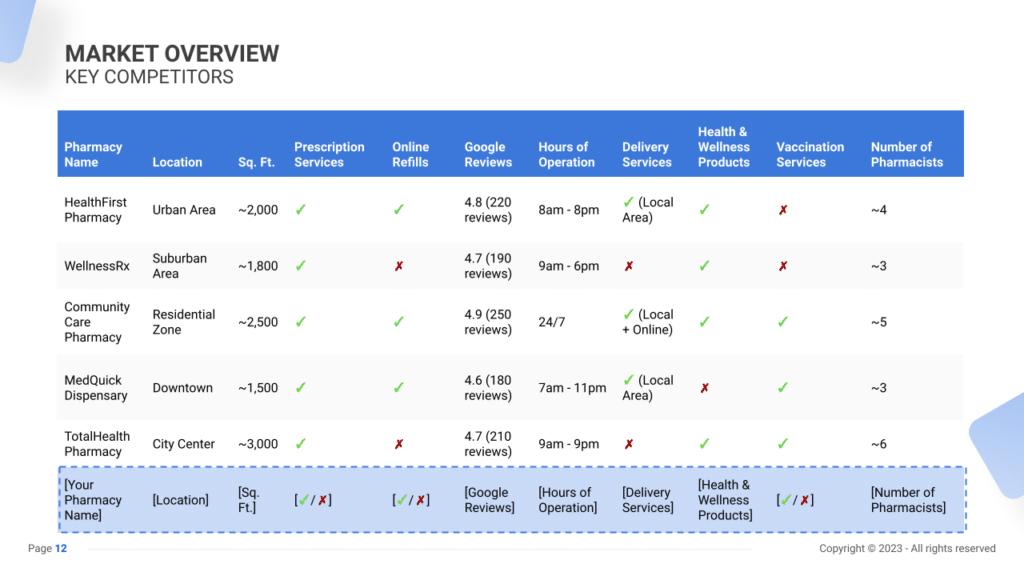
Pharmacy Competitors’ Strategies
Analyzing the strategies of these competitors involves examining several aspects:
- Service Offerings: Evaluate their range of services. If “Wellness Pharmacy” nearby is attracting attention with its holistic health consultations and herbal supplements, it suggests a market trend towards integrated health services.
- Product Range: Look at their product assortment. A pharmacy like “Community Care” that stocks a wide variety of medical devices and home health products might serve a broader customer base than one focusing solely on medications.
- Pricing and Insurance Partnerships: Assess how your pricing compares with that of your competitors. Are your products and services priced competitively with “ValueRx Pharmacy,” or do they align more with the specialized offerings at “Boutique Health”?
- Marketing and Outreach: Consider how competitors reach their audience. Do they maintain a strong online presence, or do they engage the community through health workshops and clinics?
- Customer Service and Experience: Examine the shopping experience. For example, “Friendly Pharm” may be renowned for its personal touch and patient counseling, enhancing overall customer satisfaction.
- Technological Advancements: Notice if competitors are leveraging technology to improve service, such as “MediQuick Pharmacy” with its mobile app for managing prescriptions.
What’s Your Pharmacy’s Unique Selling Proposition?
Contemplate what makes your pharmacy stand out. Perhaps you offer a comprehensive medication management program, or maybe you’re recognized for your innovative telepharmacy services.
Identify market niches through customer feedback and healthcare trends. For instance, the increasing demand for personalized medicine and pharmacogenomics testing could be a market niche if your competitors have yet to offer these services.
Consider your location: A pharmacy in a bustling city area might focus on efficiency and digital services, whereas a pharmacy in a more rural setting could emphasize community involvement and personalized care.
Strategy

SWOT
First, conduct a SWOT analysis for the pharmacy, highlighting Strengths (such as a comprehensive range of health products and services, knowledgeable pharmacists), Weaknesses (including potential inventory management issues or strong competition from large chains), Opportunities (for example, an increasing focus on healthcare and preventive measures in the community), and Threats (such as regulatory changes or online pharmacies cutting into market share).
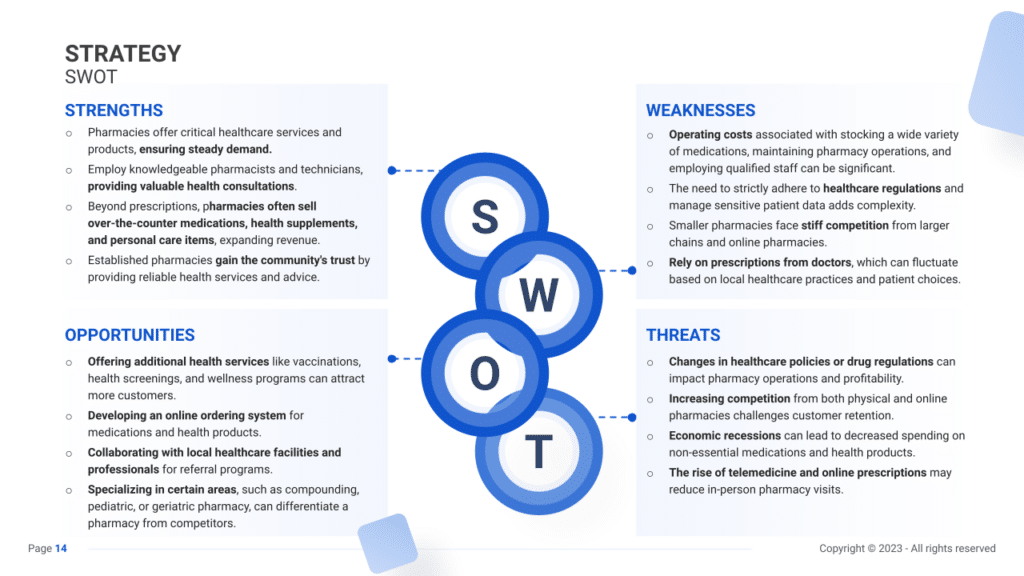
Marketing Plan
Next, develop a marketing strategy that outlines how to attract and retain customers through targeted health and wellness campaigns, promotional discounts on wellness products, an engaging online presence that includes health tips and advice, and involvement in community health events.
Marketing Channels
Leveraging diverse marketing channels is critical to reach and engage customers, amplify brand awareness, and drive foot traffic to the pharmacy.
Digital Marketing
Establishing a robust online presence is pivotal in the digital era:
- Website and SEO: Developing an informative website encompassing medication resources, health blogs, and online prescription refills enhances accessibility. Optimizing the website for local SEO ensures heightened visibility in search results for healthcare services in the area.
- Social Media: Leveraging platforms like Facebook, Twitter, and LinkedIn to disseminate health tips, promote products, and engage with the community fosters brand awareness and customer engagement.
- Email Marketing Campaigns: Regularly send newsletters containing healthcare advice, information on new medications, and exclusive offers to your subscriber base. Periodically share promotional offers, discounts, or loyalty rewards via email to incentivize customer engagement.
Local Advertising
Connecting with the local community amplifies the pharmacy’s presence:
- Print Media: Design and distribute flyers in local hotspots, community centers, and medical facilities. Advertise in local newspapers and magazines, emphasizing pharmacy services and special offers.
- Community Engagement: Participate in local health fairs, wellness expos, or charity events to interact directly with the community. Offer free health check-ups, consultations, or educational seminars.
- Strategic Partnerships: Collaborate with local healthcare providers, clinics, or wellness centers to offer joint health programs or workshops. Partner with community organizations for health-related sponsorships or fundraising events.
Promotional Activities
Strategic promotional activities to attract and retain customers:
- Health Initiatives: Offering free health check-ups, wellness consultations, or health seminars not only attracts foot traffic but also establishes the pharmacy as a proactive healthcare provider.
- Customer Incentives: Implementing loyalty programs, discounts on wellness products, or rewards for customer referrals fosters customer loyalty and retention.
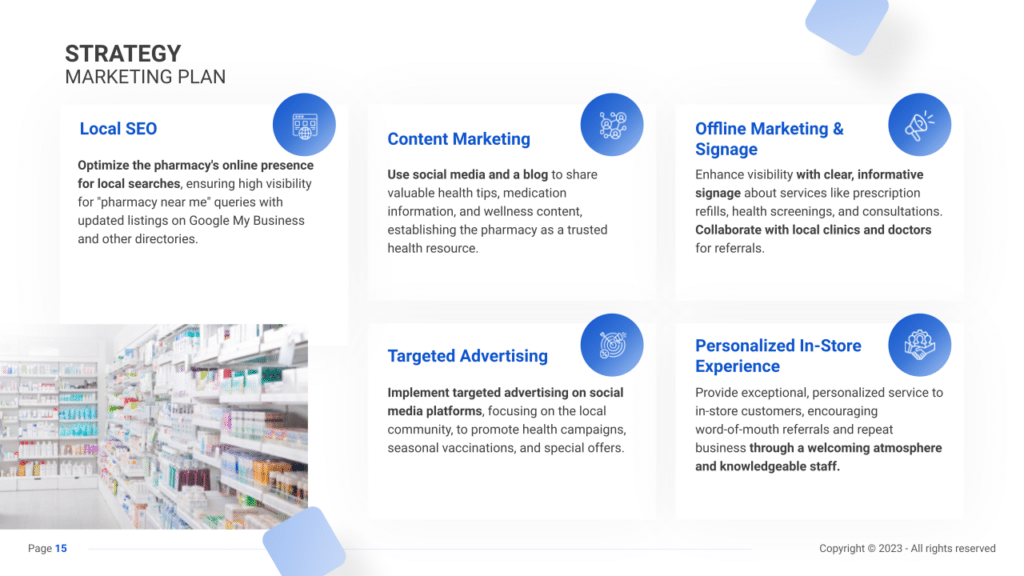
Sales Channels
Optimizing sales channels is pivotal for revenue maximization and ensuring customer satisfaction.
In-Store Experience
Enhancing the in-store customer experience within the pharmacy:
- Product Placement: Strategically displaying health-related products, supplements, and medications facilitates easy access for customers.
- Consultative Services: Providing personalized advice and recommendations on health products and wellness solutions augments the overall customer experience.
Online Sales and Services
Leveraging technology to streamline sales and services:
- Online Prescription Services: Implementing an efficient online platform for prescription refills and consultations offers customers a seamless experience.
- Telehealth Services: Introducing virtual consultations for minor health concerns provides remote access to professional advice and services.
Membership and Loyalty Programs
Fostering repeat business and cultivating customer loyalty:
- Subscription Services: Offering subscription-based services for prescription refills or wellness packages adds value for loyal customers.
- Loyalty Rewards: Initiating a loyalty program where customers earn points for purchases, redeemable for discounts or exclusive health services, enhances customer retention.
Strategy Timeline
Finally, create a detailed timeline that outlines critical milestones for the pharmacy’s opening, marketing initiatives, customer base growth, and potential service expansion objectives, ensuring the business progresses with clear direction and purpose.

Management
The Management section focuses on the pharmacy’s management and their direct roles in daily operations and strategic direction. This part is crucial for understanding who is responsible for making key decisions and driving the pharmacy toward its financial and operational goals.
For your pharmacy business plan, list the core team members, their specific responsibilities, and how their expertise supports the business.


Financial Plan
The Financial Plan section is a comprehensive analysis of your financial projections for revenue, expenses, and profitability. It lays out your pharmacy’s approach to securing funding, managing cash flow, and achieving breakeven.
This section typically includes detailed forecasts for the first 5 years of operation, highlighting expected revenue, operating costs and capital expenditures.
For your pharmacy business plan, provide a snapshot of your financial statement (profit and loss, balance sheet, cash flow statement), as well as your key assumptions (e.g. number of customers and prices, expenses, etc.).
Make sure to cover here
_ Profit and Loss
_ Cash Flow Statement
_ Balance Sheet
_ Use of Funds







